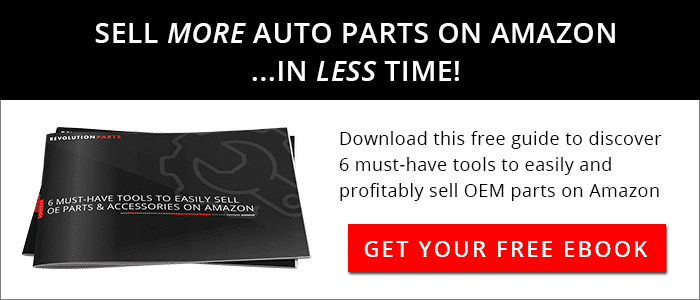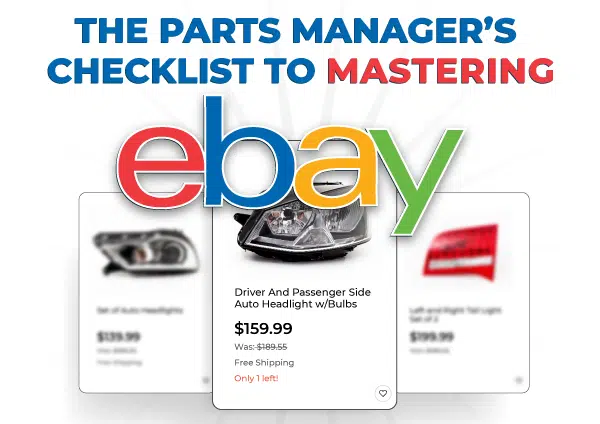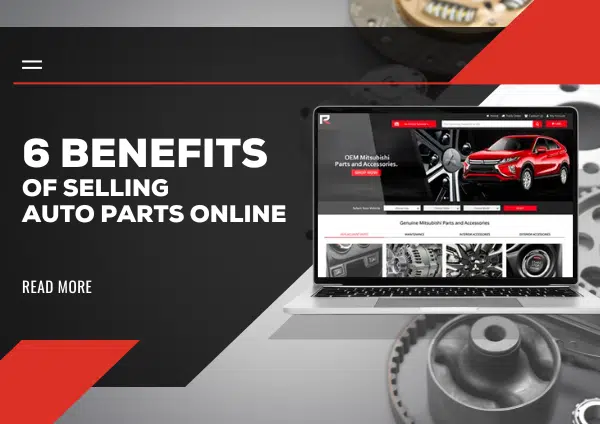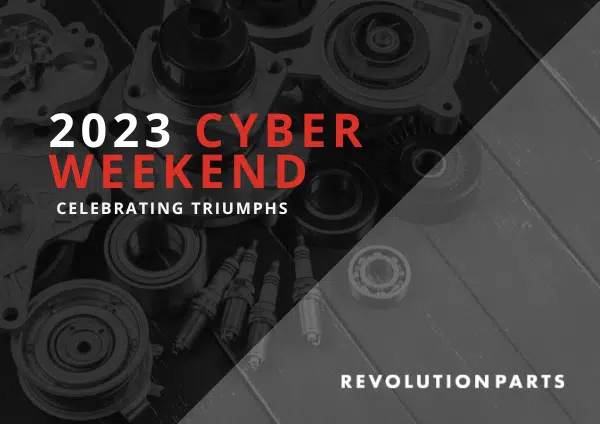There are plenty of different ways to sell online, which is a great deal for your parts team. That means you can pick exactly which channel best fits your needs and wants!
Time commitment, budget, marketing strategy, and so on… the way you choose to sell can be tailored to your situation.
Not sure which selling channel is best for you? Check out this breakdown of pros and cons for each channel to decide which one you want to try.
Of course, many dealers decide to sell in more than one place online. There’s no rule saying you have to pick ONE selling channel. That said, if you’re a first-time seller it might be best to try one channel first and add more as you get used to it.
Selling Parts on Marketplaces (eBay and Amazon)
Selling on a preexisting marketplace like eBay or Amazon is easy to get started, since the website and audience already exist. That said, you have to obey eBay’s rules when you sell.
Pros of Marketplaces:
- It’s easy to get started
On eBay and Amazon, there are already millions of ready-to-buy shoppers looking for exactly the part they need. They came there to make a purchase, putting you in a prime position to be their buyer.
You also don’t have to worry about building and maintaining a website. Other than touching up your selling profile, the selling software itself is already set up for you.
When you decide to sell on eBay or Amazon, you should take some time to prepare a simple strategy. You don’t want to run into it blind!
RELATED GUIDE: 6 Must-Have Tools to Easily Sell OE Parts & Accessories on Amazon
- No marketing necessary
For any other selling channel, you need to have some kind of marketing strategy to drive traffic to your store. With eBay and Amazon, the marketplaces do the marketing for you.
That said, there are still ways to help your store stand out. You might not need to invest in PPC advertising, but you certainly CAN use something like shipping inserts to get even more sales. You can also run promotions on eBay to get customers excited about a great sale!
- Existing customer trust and communication
On eBay and Amazon, shoppers already trust the marketplace. Even if they don’t know a seller, they know the Marketplace is looking out for everyone’s best interests.
Basically, shoppers don’t have to worry about if you’re stealing their credit card info or trying to con them. eBay or Amazon will mediate if any problems come up, which is good for both you and your customers.
Cons of Marketplaces
- More price competitive
Since it’s easier to get started on eBay, more dealerships will take advantage of that. Your prices are side-by-side with aftermarket options, so the margins won’t be quite as big.
Part of this is due to the fees. Amazon and eBay want to take a cut of your sale, and that, in turn, cuts into your profit.
But don’t be afraid! Margins will be smaller than what you’re used to at the parts counter, but you can still make money! eBay is a volume game. Even though each part is worth a smaller profit, the number of parts you sell will make up for it.
RELATED: Top 3 Surefire Ways to Increase your eBay Visibility
- Must be Marketplace compliant
You have less freedom on a marketplace, since you’re selling on their platform. This means obeying certain selling guidelines, like replying to shopper questions and shipping out the order within a certain time frame.
Shoppers who exceed the selling guidelines are rewarded (like eBay’s Top Seller Status). But if you can’t meet their minimum standards, they might not let you sell with them anymore.
- It’s harder to grow customer loyalty
Most of the branding on eBay will, of course, be eBay’s. Shoppers remember “I bought this from eBay” or “I bought this from Amazon” more than your parts store name.
This makes it more difficult to build up a following on eBay. Even though repeat shoppers are an invaluable segment of your revenue on other selling channels, you can’t really rely on that for marketplaces.
There are still techniques for building up your brand on Marketplaces, though. It just takes more effort!
Selling Parts on an Existing Dealership Website
Need something easy and low maintenance? A parts website plug-in embeds directly into your dealership website, so local customers can easily find and buy from you.
Pros of a Parts Plug-in
- It’s quick and easy to set up
Similar to Marketplaces, there’s no need to build an entire website from scratch in this case. That makes the plug-in easy to set up and install. After you’re trained up, your parts team could be selling in just a few days.
On a related note, the simplicity of a plug-in website makes it inexpensive, too!
- You already have existing local customers
Your dealership should already have a group of loyal customers, or at least shoppers who will visit because it’s the closest dealership to their location. That means you don’t have to go through the work of building up a customer base from nothing!
This also gives you an easy platform for any marketing you decide to do. For one, any visitors to your dealership website will have easy access to the parts website plug-in. You can also hand out coupons, fliers, or parts website business cards to people who visit your parts counter or service lane.
- It’s a better customer experience
A basic parts request form gets the job done, but it’s not the best experience from a customer’s point of view.
With a parts website plug-in, shoppers can browse around and find what they need. They can see images and diagrams of the parts, for example, along with price and shipping estimates.
When a customer visits your dealership website to order a part, there’s a higher chance that they’ll go through with their intended purchase!
RELATED: 4 Ways to Prevent Shoppers from Ordering the Wrong Part
Cons of a Parts Plug-in
- Limited by local area
It’s great that you already have customers visiting your dealership website, but since your dealership only focuses on local shoppers… it’s tricky to attract people who live father away!
This means your parts business is limited by a local market area, so you won’t get as many shoppers as another selling channel would bring you.
With other selling channels, you don’t have any physical limitations. You could very easily sell to parts shoppers across the country or even across the world. With that kind of reach, selling online is a great way to eliminate obsolescence.
Unfortunately, a plug-in parts website is unlikely to impact your obsolescence problem.
- Hard to sell high volume
Easy, low-maintenance part selling? This might be the channel for you. That said, don’t expect to be swimming in parts sales.
When you’re limited by your area, you simply won’t get as many shoppers. By extension, you also won’t get as many sales.
In a way, this can be good. If you chose this selling channel for an easy, low-maintenance option, then it’s for the best. You’ll get some orders, but you probably won’t have to ship out dozens of parts every day.
But if you wanted to aggressively grow your online parts business, then this isn’t the best channel to bring in tens of thousands in part sales every month. You simply won’t see the same kind of traffic that marketplaces or standalone parts websites get.
Selling Parts on a Standalone Parts Website
The sky is the limit when you launch a standalone website. With your own parts website, you can set your own rules—design, pricing, shipping, etc—and aggressively grow parts department sales how YOU want to.
Pros of a Standalone Parts Website
- High volume sales
If you want a channel that helps you aggressively grow sales, then this might be the one for you!
As long as you have a marketing strategy in place, you can attract shoppers to your website. Then you just need to convince them to make a purchase… and since you have complete control over your parts website, it’s easy to optimize until your chances are pretty good.
When you combine a solid pricing matrix with quality customer service, you can even start building a loyal customer base that comes back to shop with you any time they need a part.
And unlike selling on Marketplaces, you don’t have to worry about fees eating into your profits.
- No geographical limits
You’re not limited to a local market area when you sell on your own website. It’s easy to take your parts business across the country—or even across the world!
When you expand your market reach to a national or international level, the number of potential customers multiplies tenfold.
With such an expanded customer base, this also makes a standalone parts website ideal for eliminating obsolescence. There’s a much higher chance that you can find a customer who needs those old parts on your warehouse shelves!
- You get complete control
We’ve already touched on it in some of the other points, but we have to dedicate an entire bullet point to this one…
With a standalone parts website, you get complete control!
The website design, for example, is completely up to you. We can’t speak on behalf of other parts eCommerce solutions, but with RevolutionParts you have many unique website themes to choose from. From there, you can work with our design team to rearrange sections, set up new pages, create custom banners, and so on.
You also get control over how you choose to sell. You can set up unique policies for shipping, returns, and cancellations to best fit what your team can handle.
And, of course, you can set your own pricing and shipping strategies. Build a pricing matrix to balance out your prices, for example, and play around with different margins.
Even though you can build a pricing matrix on any channel, marketplace margins are more restricted by competition, and many plug-in sites will simply choose to match their counter pricing for parts. A standalone Web Store gives you more flexibility in pricing.
Cons of a Standalone Parts Website
- Takes more time to set up
Since your parts eCommerce solution is building your parts website from the ground up, it takes some time to get ramped up.
There’s also more training involved in setting up and optimizing your store. While the design team works on creating your website, the customer success team will be helping you learn your way around the platform.
At RevolutionParts, it takes about 2 weeks on average to launch a standalone parts website. Some dealerships are able to launch in less time, but it’s really important to us that you’re properly prepared before your Go Live date.
Some eCommerce solutions just want to churn our new parts websites like a conveyor belt and push you out the door before you’re ready, which can be a frustrating experience for first-time sellers.
- It requires marketing of some kind
In order to success on your parts Web Store, you NEED some kind of marketing.
Unfortunately, a lot of dealers think you can take a “set and forget” approach to running a parts website, but that’s not the case. Whether you do the marketing yourself, hire a marketing agency, or rely on your auto group’s internal marketing team, you must do SOMETHING.
From what we’ve seen, PPC advertising and SEO are the two main ways to drive traffic to your parts website. PPC advertising is something like Google search or shopping ads, which can get a bit complicated if you don’t have any experience with Google ads. We recommend leaving it up to your marketing agency!
As for SEO, a lot of factors can affect how high your parts website appears in Google search results. Some of the factors are technical and outside of your control, but you can write unique content (like car part descriptions) to show Google that your website contains quality content.
RELATED: How to Boost the Google Ranking of your Parts Website in 6 Easy Steps
And there’s so much more you can do, too! Here’s a short list of some other techniques you can try:
- Must know some best practices to maximize success
We’ve said it before, but here it is again: a “set-and-forget” strategy just won’t cut it online.
After you launch the parts website with some default settings, you should take some time to learn about parts eCommerce best settings. Things like how to create a good pricing matrix, tips for saving money on shipping, and so on.
Currently, there’s still a lot of opportunity and room for growth in the only parts market. That said, as more dealerships get started online, it’ll be harder to take the “easy way” to success. You’ll have to hone your strategy and pick up tricks when you can to save time on eCommerce, boost profitability, and find more customers.
Since you’re reading this, you’re in good shape! The RevolutionParts resource center is the best place to learn the latest tips and tricks for parts eCommerce success. Stay posted for more every week!





